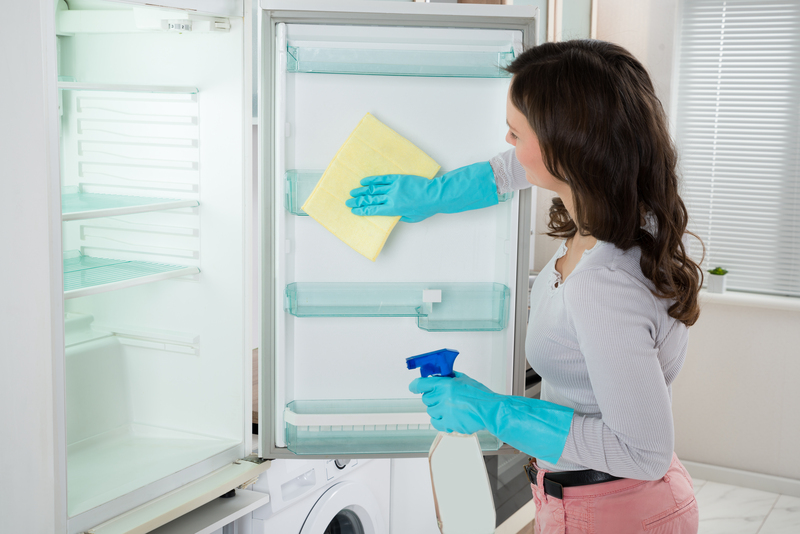Velvet Curtain Care: A Guide to Washing and Preserving Beauty
Posted on 01/06/2025
Velvet Curtain Care: A Guide to Washing and Preserving Beauty
Velvet curtains add a touch of opulence and warmth to any room. Their luxurious texture, deep colors, and characteristic sheen make them a popular choice for home decor and theatres alike. However, the unique nature of velvet fabric makes proper cleaning and care essential to maintain their elegance. In this comprehensive guide, we'll explore the best practices for velvet curtain care, covering everything from daily maintenance to deep cleaning and long-term preservation. Whether you're a proud owner of plush, vintage drapes or new, modern velvet panels, these tips will help ensure your curtains retain their beauty for years to come.
Understanding Velvet Fabric
Before diving into the specifics of how to clean velvet curtains, it's important to understand what makes velvet so special - and so delicate.
What Makes Velvet Unique?
Velvet is a distinctive woven fabric, characterized by its short, dense pile and luxurious feel. It's typically made from fibers such as silk, cotton, rayon, or synthetic blends. The pile, or raised loops and threads, is what gives velvet its soft texture and lustrous appearance. Unfortunately, that same pile is also susceptible to crushing, matting, and staining, making velvet window treatments more challenging to care for than other fabrics.
Types of Velvet Used in Curtains
- Silk Velvet: The most expensive, offering unmatched luster but also the most delicate.
- Cotton Velvet: Durable but can attract dust and may fade.
- Synthetic Velvet: Polyester or rayon blends are more budget-friendly and tend to be easier to maintain.
Identifying what kind of velvet you have is crucial to select the correct velvet curtain cleaning method.

Day-to-Day Velvet Curtain Maintenance
Routine care is the first step in ensuring your curtains remain stunning year after year. These daily and weekly tips will help prevent dirt build-up, pile damage, and fading:
1. Regular Dusting and Vacuuming
- Use a Soft Brush Attachment: Gently vacuum your velvet curtains using a handheld vacuum or upholstery attachment set on the lowest suction. Move in the direction of the pile to avoid crushing.
- Shake Out Dust: On curtain cleaning days, take the curtains down and gently shake them outdoors to remove dust.
2. Avoid Direct Sunlight
Exposure to direct sunlight can cause velvet to fade dramatically over time. Use blinds, shades, or sheer drapes behind your velvet curtains to protect them from harsh rays and preserve their richness.
3. Handling Spots and Stains Quickly
- Blot, Don't Rub: If a spill occurs, gently blot the area with a clean, dry cloth to absorb liquid. Avoid rubbing or scrubbing, which can crush the pile and spread the stain.
- Mild Detergent Solution: For tougher spots, use a solution of cool water and a drop of mild dish soap. Dab gently and let air dry completely.
In-Depth Washing of Velvet Curtains
When simple dusting isn't enough, it may be time to deep clean your velvet drapes. Depending on the fabric content, this could be done at home or require professional expertise. Here's how to approach washing velvet curtains properly:
1. Check the Manufacturer's Label
- Read the Cleaning Instructions: Always consult the care label before attempting to wash velvet curtains. Some may be labeled as 'dry clean only,' while others may allow gentle hand washing or even machine washing.
2. Home Washing Guidelines
For velvet curtains labeled as washable (usually synthetics or certain cotton blends):
- Hand Wash Preferred: Fill a bathtub or large basin with cool or lukewarm water and add a mild, gentle detergent.
- Soak and Swish: Immerse the curtains and gently move them through the water. Avoid wringing or twisting.
- Rinse Thoroughly: Drain the soapy water and rinse curtains until all detergent is gone.
- Blot Excess Water: Lay the curtain flat on towels and roll to gently remove water. Hanging while sopping wet may stretch them out of shape.
3. Machine Washing Velvet Curtains
- Use Delicate Cycle: Place curtains in a laundry bag and wash on the gentlest setting, with cold water and mild detergent.
- Minimal Spin: Choose the lowest possible spin setting to prevent pile crushing.
- Never Overload: Wash one or two panels at a time to allow water and detergent to circulate freely.
4. Drying Velvet Curtains
- Air Dry Flat: Lay curtains flat on towels or hang them back onto the rod to drip dry naturally. Never tumble dry velvet, as the agitation and heat can ruin the fabric.
- No Direct Heat: Avoid using a hairdryer, radiator, or placing in front of a heater.
5. Professional Cleaning for Delicate Vintages
- If your curtains are made from silk velvet, are antique, lined with intricate fabrics, or labeled as 'dry clean only,' it's safest to leave cleaning to professional dry cleaners experienced with luxury fabrics.
Preserving the Beauty of Velvet Drapes Long-Term
Proper Storage Matters
- Keep Away from Moisture: When storing velvet curtains, ensure the storage space is dry and well-ventilated. Dampness can encourage mold and mildew.
- Roll, Don't Fold: If not hanging, roll curtains loosely around a sturdy tube. Folding can create permanent creases that flatten the pile.
- Use Cotton Covers: Store curtains in a cotton sheet or bag to allow the fabric to breathe, avoiding plastic which traps moisture.
Minimizing Wear and Tear
- Rotate Curtains: If your windows allow, periodically switch left and right curtain panels to distribute sunlight and wear evenly.
- Use Curtain Lining: Investing in quality linings for velvet curtains can block dust and UV rays, preserving color and pile integrity.
How to Revitalize Velvet Curtains
Brushing and Steaming Techniques
- Use a Special Velvet Brush: Gently brush your curtains from top to bottom in the direction of the pile. This "lifts" the nap, restores softness, and removes minor debris.
- Steaming: Hold a handheld steamer a few inches from the curtain and move in smooth strokes. The steam will refresh the pile and remove light wrinkles, without crushing the delicate fabric.
- Never Iron Directly on Velvet: If you must use an iron, place a velvet-safe cloth between iron and curtain and use the lowest setting, with no steam.
Dealing With Flattened Pile
Over time, heavy or improperly handled velvet can develop flattened, dull areas. To revive these spots:
- Dampen a lint-free cloth and dab lightly over the affected area.
- Use a soft brush to gently lift the pile as you steam.
Persistent problems may require a professional velvet restorer.
Common Mistakes to Avoid in Velvet Curtain Care
- Using Harsh Chemicals: Bleach and strong cleaners can permanently discolor and damage velvet fiber.
- Scrubbing or Rubbing: Always use a gentle touch. Rough handling can crush the pile or cause pilling and pulls.
- Skipping Spot Tests: Before applying any cleaning solution, always perform a test on a hidden area to check for colorfastness.
- Excessive Water Use: Oversaturating velvet leads to water stains and may encourage mold growth if not dried properly.
- Direct Sunlight Drying: Air dry curtains in a shaded, well-ventilated area away from direct sunlight.
Frequently Asked Questions About Cleaning Velvet Curtains
Can you machine wash all velvet curtains?
No, only certain synthetic and durable cotton velvet curtains are safe for washing machines, and always on a delicate cycle. Always check your care label before proceeding.
Is it safe to use a lint roller?
Yes, a lint roller can help remove dust and lint from velvet curtains, but be gentle to avoid pulling threads or flattening the pile.
How often should velvet drapes be professionally cleaned?
For homes with low dust or allergens, professional cleaning every 1-2 years is sufficient. If your velvet curtains are in a high-traffic room or have visible soiling, annual cleaning is recommended.
What about steam cleaning velvet curtains?
Steam cleaning can freshen up and deodorize velvet curtains and is generally safe for synthetics and cottons. However, for silk velvet, always consult a professional first.
DIY vs. Professional Curtain Cleaning: Which Is Right for Velvet?
When deciding between doing it yourself or hiring an expert, weigh these factors:
- Colorfastness: If unsure whether dyes might bleed, professional cleaning is safer.
- Size and Weight: Large, stage-sized drapes are best handled by pros with specialty equipment.
- Antique Value: Vintage or high-dollar drapes deserve professional care to prevent unintentional damage.
- Modern Synthetic Curtains: More forgiving to at-home washing, but ensure your techniques are gentle and precise.

Eco-Friendly Velvet Curtain Cleaning Tips
- Opt for Natural Cleaners: Diluted white vinegar is a gentle deodorizer and cleaner for many fabrics, though always spot-test first.
- Less is More: Use minimal detergent to avoid excess residues.
- Air Drying: Saves energy and prevents heat damage to velvet's pile.
Final Thoughts: Keep Your Velvet Curtains Stunning
Taking time to care for your velvet drapes isn't just about cleanliness--it's about preserving an investment in beauty and luxury. Routine dusting, gentle hand or machine washing when safe, and regular steaming or brushing will ensure your curtains look magnificent year after year. By following the guidelines in this velvet curtain cleaning guide, you can enjoy the elegance of velvet in your home, knowing it's well cared for.
Remember: When in doubt, consult a professional. Plush, well-maintained velvet will draw admiring glances and transform your living space long into the future.
With the right approach, your velvet curtains can remain the crowning glory of your home's decor for many years to come.









